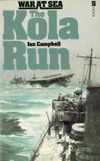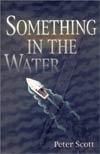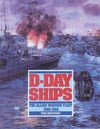The Kola Run
MacIntyre, Donald and Campbell, Ian
1958, Frederick Muller Ltd.
Hardcover, 254 pages, 6 maps, 32 illustrations
| Type. | Campaign Operational History |
| Pros. | First, solid, thorough operational account of the Arctic Convoys. Exceptional narrative style and evocative description, anecdotes and humour. Very clear maps, many effective photos not seen since, and very useful statistical appendices. |
| Cons. | Only describes RN operations, with natural focus on surface operations, both anti-ship and ASW, whereas most recent books have balanced RN and Merchant Navy experiences and operations. |
| Rating. |  |
 Campbell and Macintyre's 1958 operational history is still today practically the standard work on the campaign. The Kola Run has resisted the challenge of several recent large volumes of arctic convoy history through the quality of its diction, description and narrative style, and the involvement and proximity of its authors. Woodman's Arctic Convoys, Paul Kemp's Convoy and Mark Evans' Great World War II Battles in the Arctic, together supersede the details, scale and range of Campbell & Macintyre, as well as including such details as the separate conventional naval and commando operations before and during the convoy period. Woodman's work also includes substantial coverage of the merchant vessels and seamen which were the core of and reason for the history. Campbell & Macintyre, despite their abilities, continued the normal RN bias of the period toward operational matters and action, and away from merchant shipping.
Campbell and Macintyre's 1958 operational history is still today practically the standard work on the campaign. The Kola Run has resisted the challenge of several recent large volumes of arctic convoy history through the quality of its diction, description and narrative style, and the involvement and proximity of its authors. Woodman's Arctic Convoys, Paul Kemp's Convoy and Mark Evans' Great World War II Battles in the Arctic, together supersede the details, scale and range of Campbell & Macintyre, as well as including such details as the separate conventional naval and commando operations before and during the convoy period. Woodman's work also includes substantial coverage of the merchant vessels and seamen which were the core of and reason for the history. Campbell & Macintyre, despite their abilities, continued the normal RN bias of the period toward operational matters and action, and away from merchant shipping.
Their work is still however the classic account of the campaign. It was written by former participants in the traditional style of Admiralty-approved books. It was a full length account of the significant events, though not of every event, unlike some more recent accounts which really have been thoroughgoing. Works before Kola Run had been brief and not official, little more than sensational journalistic collections of wartime news and immediately post-war Government gazettes. Works between 1960 and 1990 concentrated on the key battles (Barents Sea and North Cape), key convoys (PQ-17 and PQ-18), or on certain ships or voyages (PQ-12, the damage to and loss of the cruisers HMS Trinidad and Edinburgh for instance). PQ-17 is of course a separate and controversial genre, usually discussed by a different sort of author.
Although they began their account with a discussion of the beginning of the war at sea followed by the German attack on the USSR (which has been used so frequently since as to be a cliché), their masterful diction and coverage set the scene of convoy warfare and the arctic environment perfectly. After this, the strategic significance of the route and the reason for its use were examined. The Iranian Route was not favoured by the Soviets. It ran close to areas they considered vulnerable and wanted to keep free of Allied influence, as well as a limited capacity railway line north into the new industrial heartland of the USSR. The Vladivostok route, by US convoys across the North Pacific, also fed into a closed, vulnerable, strategically sensitive area. Worse, it was a strictly seasonal route: the Kola Run terminated in the only all-weather ice-free port in the USSR: Murmansk (and more seasonally, Archangel). Ironically, Murmansk had been developed for deploying Allied troops into the USSR in support of anti-Communist forces during the Civil War of 1918-22. Equally ironically, US shipping to Vladivostok was untroubled by Japanese warships or aircraft throughout the war. With peace between the USSR and Japan, there was no risk to the merchant ships or their cargoes, in the starkest possible contrast to the situation in the Barents Sea, and between the US and Japan everywhere else.
Throughout the book, as in every other description of convoy warfare (again amounting to a cliché), the environment and the weather were as significant as the enemy. Amid the problems of finding shipping and the war supplies to fill it, were those of providing the escorts for yet another convoy route. The demands of the Atlantic and Mediterranean theatres were already taxing the RN to the limit. The technical limitations of RAF aircraft and RN ships, weapons and sensors were examined. These fully apprise the reader of the difficulties of a convoy passage in either perpetual sunlight, cloud, fog, or dark. The Arctic route was an Atlantic convoy where almost the entire passage was under German air cover. There was no New York at one end and no home at the other. Instead, at one end was a threatened, stockaded Britain, rationed and under attack; at the other a closed, traumatised society, crushed by its own government and daily punished by a ruthless enemy. Added to these were the hazards of the latitude: a route where even in summer there were icebergs and mush, terrible storms with the strongest winds and largest seas anywhere on earth; a passage where the Greenland-Iceland section of the Atlantic route was the whole scene. Steel became brittle through cold-soaking, weapons seized and jammed even when lagged and kept moving; men lived in perpetual cold no matter how many layers they wore, and ate, worked and slept in dim, damp, cramped tubercular steel boxes, afloat in a sea which took a minute or two to kill. Importantly, C & M emphasised these problems were also experienced by 'the enemy'. The Germans were either in the few large ships incarcerated at Hitler's orders in bleak far northern anchorages, and forced to wither on the vine by restrictive orders and the lack of oil fuel; in bare airfields on the edge of the scene, facing an equally brief life if lost to flak or failure; or in the U-boats which were subjected to the same risks of sea, cold, ice and wind as the escorts they fought. They too had trouble finding and attacking targets, keeping the ice out of moving parts and off superstructures. They also faced the same extinction from explosives, temperature, or mechanical failure.
From this solid base C & M discussed the few early convoys untroubled by German attacks, the growth of resistance, the losses mounting as the convoy cycle and size increased, and the individual actions and events. At each point the incidents were described in rich, evocative terms, whether the dimness of the polar day, the ferocity of the weather, the colours of the explosions, or the sensations the men felt. The risks and the stress were always obvious. These were shown by the sense of conjecture felt by convoy escort commanders after storms which dispersed their charges, or whether the dim shapes to their north were large enemy destroyers, small Soviet destroyers, of separated members of his own screen, or the frustration felt by escort captains faced with water which continually deflected the ASDIC beams searching for U-boats below, and the poor equipment which could not sink the enemy. The all-enveloping blend of cold, tension, sleep-deprivation, the limitations of machinery, the importance of the voyages and the apparent indifference of the Soviet ally, were seen to oppress the participants at all times.
The authors continued their evocative coverage as the losses and the dangers grew with every new convoy. Each successive PQ convoy leading to the debacle of PQ-17 and the guarded success of PQ-18 were shown, with balance, skill, and clarity. The cause of PQ-17 was largely left untouched, as the authors focus on the actual situation and its consequences, at considerable length. The hostility of the sea and the bleakness of the situation for the seamen, were clear. C & M merely stated that the scattering of PQ-17 was "surrounded with imponderables" and "the choice must always be left to the man on the spot". This was all the discussion needed in 1958: Adm. Pound was responsible, and at fault. The forces and fighting of PQ-18 were then narrated equally effectively, always without sentiment, but with consideration and compassion.
Amid the unmatchably vivid descriptions of actions and storms are more pastoral and domestic scenes, of ships riding at anchor in the Clyde, collecting in Loch Ewe or more precariously in Hvalfjordur, Iceland. There are equally vivid and scathing descriptions of the cruelty and harshness of the Soviets. Indeed (though not surprisingly for 1958, amid Cold War tension), the USSR comes in for more criticism than the Kriegsmarine or the Luftwaffe. The latter were the enemy, and deserved respect for their courage and strength under the same terrible conditions as the merchantmen and escorts. The Soviets were allies of convenience, always officially ungrateful and demanding of the US and UK, the latter which frequently deprived its own armies to send tanks, aircraft and explosives to the USSR. The Soviet navy was large, if ill-equipped, and rarely sortied from harbour to protect or support its Allies. Soviet personnel were unofficially welcoming, and the common people especially hospitable and grateful, but always suspicious of these capitalist degenerates from across the sea. The spectre of propaganda and political re-education were more prominent in the author's discussions of conditions in Murmansk than in descriptions of U-Boat crews or the few frozen survivors recovered from the German ships sunk by the RN.
The third section of the book dealt with the larger conventional combats of the campaign: those where the convoys took the back seat and the covering forces shone: the cruisers and destroyers forcing away the heavy units of the Kriegsmarine from JW-51B on New Year's Eve 1942 and the final large RN surface action of the war: the tragic aborted thrust by Scharnhorst against JW-55B on Boxing Day 1943.
After this the offensive period of the campaign was the focus. Here was seen fewer and fewer U-boats attacking large, well-protected convoys of Liberty ships, filled with US Lease-Lend war supplies, covered by numerous corvettes, destroyers and new frigates, and with the addition of long range aircover, and revolutionary carrier-borne aircraft: British Swordfish with British radar operating from US-produced Liberty hulls. Hunting and killing U-boats with the aid of radar, HF/DF, and sheer numbers had taken the place of shepherding rusty old freighters and tankers past almost invisible, stealthy enemy submarines, tearing at the flanks. Losses had reversed, less dramatically than in the Atlantic, but the campaign had swung firmly in the Allies' favour. It was, in the classic wording of the authors, "Convoy defence perfected." They finished with a discussion of the value of the route and the service the RN provided, as this was after all a service history; largely that of RN ships, not an account of the entire campaign. After the war, the Barents sea reverted to its historic role: mostly undisturbed by the passage of ships and men, "the storms venting themselves on empty skies and ship-less seas. Long may it remain so." This too betrayed the period of the book. In 1958 the Barents Sea was still developing into the ultimate Cold War battleground: polar overflights and interceptions, stand-offs between submerged submarines, SONAR nets and nuclear sabre-rattling. These were "the ingredients of the Kola Run" after 1958, prophetically described by MacLean in his classic novel Ice Station Zebra, just as he had evoked the terrors and dangers of the wartime Kola Run in his first and best novel, HMS Ulysses. From that and C & M's Kola Run can be gained as vivid and as powerful a picture of the arctic convoys as can be imagined, for all the inaccuracies and compressions neccesary to fictional narrative.
Campbell and Macintyre were able to balance the need to discuss the significant events of the campaign, with the essentials of convoy escort and defence in Northern waters. They were also able to combine accuracy and balance with great written style and flair. Kola Run is still a great read as well as a solid history. It would be invidious to say that the powerful style and narrative is more Campbell than Macintyre, based on a comparison with the latter's later works. That it has been superseded by books with more and better sources, written decades later, is no defect. Its prose and style still place it equal with the fuller works of the last ten years.
The reviewer welcomes your comments on this review.
Review written by Ian Campbell, Launceston, Tasmania.
Published on 12 Oct 2001.
This title is highly recommended.
Return to our main review page.



